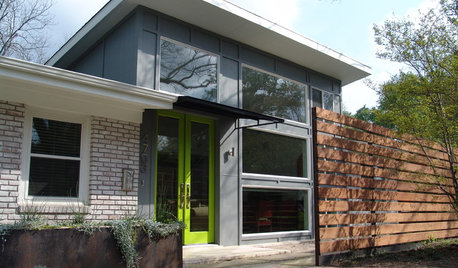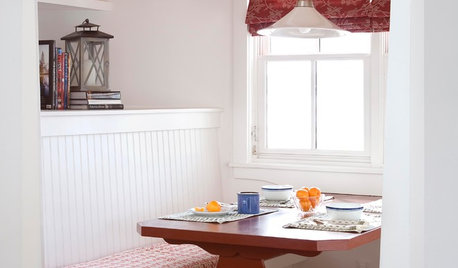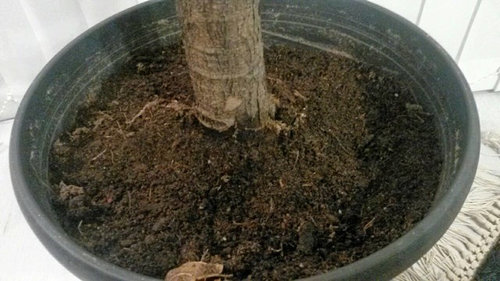A Green Awakening: my new flatmate!
fizzymartini
8 years ago
Featured Answer
Sort by:Oldest
Comments (40)
Mentha (East TN, Zone 6B-7A)
8 years agolast modified: 8 years agofizzymartini thanked Mentha (East TN, Zone 6B-7A)Related Discussions
Sloooooow Awakening
Comments (17)BD21, if I had to guess, the white would be 'Shirayukihime' due to the different colored stamens than 'Henryi'. Not sure if 'Sensation' would make it....it says some lilacs to the northern reaches of Zone 9. Thanks Jim, we just gotta hang in there, we know they'll bloom someday, right? Juliet, you are such a sweetie. What makes me smile is when my girls come (nieclings) and they discover something new in the garden they have never seen before :-) Their step grandmother had to take the Access bus to get here and she won't have many left so this one was special. inga, that red is a smaller version or I could have never had it here. I chose it to play off my green and red Japanese maples that share the front yard with it. Rita, your roses are incredible this year. I was going to post on your thread to tell you so but just got so far behind trying to get everything done. I still remember when you were first envisioning those new beds. As owners to design, we can only hope they turn out how we imagine them, you should be proud ;-) Thanks Krista, one thing about things being late, they still know the order of go so they give you time in between to prepare for the next flush. Rhodies and azaleas in particular are a lot of work to deadhead. Inga, thank you. I was actually thinking about you because I have some escallonia above my pond that has tried my very last bit of patience and is going to get SPed. Rugosas are used extensively up here for freeway median plantings (low maintenance) and I'm thinking about either a combo of them or maybe some OGRs. When I get a chance I'll post a pic of the spot. Carol, that Sensation is really growing on me. It's about 10' tall and is between a pink rhododendron and that pink Homebush I posted a pic of. The fragrance whaffs down to the swing where we sit in the evening with the poms and the cat. This is a pic from last year........See MoreRose shots today with my new camera
Comments (14)One work-around I've found for that, Marlorena, is to back up and take the shot from a further distance. The camera will likely get all items in focus, doing that. Then you can take advantage of the great resolution the camera has by cropping and enlarging that portion of the photo, so it is like a close-up. Another trick is to experiment with the plane of the shot. By slightly depressing the shutter button, the camera will show you which areas are in focus in the field of view by surrounding those with green rectangles. If you tilt the camera slightly or shift it to a slightly different view, you will often find you can bring more of a view into focus by doing that kind of adjustment....See MoreMy KBG lawn is 50% green and dead blades
Comments (13)A "pack" is usually offered by labs as a pre-paid soil test which includes a bag for the soil sample and a box addressed to the lab and sometimes postage paid. Laboratories that offer (most do) a "pack" will mail it to you after you order and pay for the desired service. Alternatively, you can print off an soil test order form and enclose it with your check for the test using a soil sample in your own zip lock bag and in a box which you can get at the post office. Before doing anything, may I suggest: Proper and consistent soil sampling is a must in order to reduce inconsistencies and get the most accurate results possible. Proper: When digging the samples, use only high quality steel tools. Use only plastic buckets for holding and mixing the samples. Avoid brass, galvanized or other zinc coated utensils. Otherwise, the sample can be contaminated. If you do not have a soil sampling tool (auger or probe), insure that your soil sample is an even thickness vertical slice and not a wedge shaped slice. Take 8 samples, evenly dispersed, from each 60 x 60' area. Try not to sample any sooner than 30 -60 days after an amendment application. Consistent: Take all samples to the same depth (4" for turf) and do so each year of testing. Use the same "range" of soil for each sample and from year to year. e.g. soil from the 0" depth down to the 4" depth (preferred, but remove the soil surface and any fertilizer prills it may contain). or from 1"-4", or the 2" to 4" depth, etc., if so suggested. Stay consistent. Take the samples in the same month each year. Use the same lab each year. Use an established professional or university lab that offers a broad menu of testing processes, reports results in ppm or lbs/acre and at a minimum, reports CEC/TEC, Ca, Mg, P, S, K, Na, OM, Mn, Zn and Cu. Verify that they offer ammonium acetate cation and buffer pH testing and that their fees are reasonable. Verify if they use Mehlich III (unless otherwise recommended) as their default extractant and extra points if they offer Bray and Olsen too. Do the vinegar test on a small sample. If it fizzes, request that an ammonium acetate test be performed. If it doesn't fizz, either ask for or be prepared to request that (if the test comes back with a soil pH less than 6) a buffer pH test be done. For labs, in addition to those you linked to: There are a number of alternatives by region. e.g. A&L Eastern located in Virginia or the Carolinas for the S. E. and N.E. Another choice for the N.E. is Agro-One which is associated with Cornell (http://dairyone.com/wp-content/uploads/2014/01/Form-T.pdf). Spectrum is used by a large number of farmers in the Eastern U.S and Mid West (but their default is a buffer pH calculation for lime, not a buffer pH TEST, so make sure you request an additional buffer pH TEST when sending the sample to them), but any lab that does Mehlich III is good for Midwest soil testing. West of the Mississippi, I'd say probably A&L Western located in Cal. or Oregon. Last I checked they all offer recommendations, but verify that a buffer pH TEST (Not a calculation) and results are included (or at least is available at a reasonable cost) in the report before you order. Post back with any questions, I'll try to answer them this afternoon when I get back....See MoreAwakening in the middle of the garage?
Comments (29)Me, too, Bart! I grew both Perennial Blue and Purple Skyliner in the Encino garden where neither was really suitable. It was too hot, too dry and far too brilliant sunlight with nowhere to really grow either well. I WANT yards of "ever purple" something and just may have to beg a piece once there is something here, upon which to drape it!...See Morefizzymartini
8 years agotapla (mid-Michigan, USDA z5b-6a)
8 years agolast modified: 8 years agofizzymartini thanked tapla (mid-Michigan, USDA z5b-6a)Dave
8 years agotapla (mid-Michigan, USDA z5b-6a)
8 years agolast modified: 8 years agoDave
8 years agolast modified: 8 years agofizzymartini
8 years agofizzymartini
8 years agolast modified: 8 years agotapla (mid-Michigan, USDA z5b-6a)
8 years agofizzymartini
8 years agofizzymartini
8 years agofizzymartini
7 years agolast modified: 7 years agotapla (mid-Michigan, USDA z5b-6a)
7 years agofizzymartini
7 years agofizzymartini
7 years agofizzymartini
7 years agotapla (mid-Michigan, USDA z5b-6a)
7 years agoDave
7 years agolast modified: 7 years agofizzymartini
7 years agolast modified: 7 years agofizzymartini
7 years agolitterbuggy (z7b, Utah)
7 years agofizzymartini
6 years agofizzymartini
6 years agoTiffany, purpleinopp Z8b Opp, AL
6 years agofloral_uk z.8/9 SW UK
6 years agolast modified: 6 years agotapla (mid-Michigan, USDA z5b-6a)
6 years agofizzymartini
6 years agotapla (mid-Michigan, USDA z5b-6a)
6 years ago
Related Stories

GARDENING GUIDESEvocative Plants to Awaken All the Senses
Slip into a garden wonderland that brings more than mere visual delight, by including these grasses, flowers and herbs
Full Story
GARDENING GUIDESGreat Design Plant: Corylus Americana Awakens the Woodland Garden
Plant American hazelnut for three seasons of interest and to feed our furry and feathered friends
Full Story
FRONT DOOR COLORSFront and Center Color: When to Paint Your Door Green
Fresh, fun and a pleasant surprise on a front door, green in subtle to strong shades brings energy to home exteriors
Full Story
CONTRACTOR TIPSBuilding Permits: What to Know About Green Building and Energy Codes
In Part 4 of our series examining the residential permit process, we review typical green building and energy code requirements
Full Story
COLOR4 Hot Color Trends to Consider for 2013
Bring some zing to your rooms for the new year, with high-energy shades that open the eyes and awaken the spirit
Full Story
FOLIAGEGreat Design Plant: Foxtail Fern
Not actually a fern, this vivid member of the asparagus family has a distinctive appearance to awaken a garden year-round
Full Story
COLORColor Feast: When to Use Red in the Dining Room
It awakens appetites and spurs conversations, but too much is like a second helping of pie. Find the perfect balance of dining room red here
Full Story
KITCHEN DESIGN19 Ways to Create a Cozy Breakfast Nook
No rude awakenings here. Start your day the gentle way, with a snuggly corner for noshing
Full Story
KITCHEN DESIGNA Rainbow of Colorful Kitchen Stools
Brighten your kitchen with seating in red, orange, yellow, green, blue or violet
Full Story
SHOP HOUZZShop Houzz: A Space Inspired by ‘Star Wars’
The answer to this deep question might just depend on your favorite colors
Full Story0
































Tiffany, purpleinopp Z8b Opp, AL